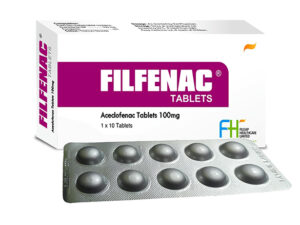
FILFENAC® TABLETS
Aceclofenac Tablets 100 mg
DESCRIPTION
Aceclofenac is a non steroidal anti-inflammatory drug (NSAID). Aceclofenac has higher anti-inflammatory action than conventional NSAIDs. It works by blocking the action of a substance in the body called Cyclo-oxygenase. Cyclo-oxygenase is involved in the production of prostaglandins (chemicals in the body) which cause pain, swelling and inflammation. Aceclofenac is the glycolic ester of Diclofenac.
INDICATIONS
Aceclofenac is indicated for the relief of pain and inflammation in osteoarthritis, rheumatoid arthritis and ankylosing spondylitis. It is used also in toothache, trauma and lumbago to relief pain and inflammation.
PHARMACOLOGICAL PROPERTIES
Pharmacodynamic properties
Aceclofenac is a non-steroidal agent with marked anti-inflammatory and analgesic properties.
The mode of action of aceclofenac is largely based on the inhibition of prostaglandin synthesis. Aceclofenac is a potent inhibitor of the enzyme cyclo-oxygenase, which is involved in the production of prostaglandins.
DOSAGE & ADMINISTRATION
Aceclofenac film-coated tablets are supplied for oral administration and should be swallowed whole with sufficient quantity of liquid.
To be taken preferably with or after food. When Aceclofenac was administered to fasting and fed healthy volunteers only the rate and not the extent of Aceclofenac absorption was affected.
Undesirable effects may be minimized by using the lowest effective dose for the shortest duration necessary to control symptoms.
Adults
The recommended dose is 200 mg daily, taken as two separate 100 mg doses, one tablet in the morning and one in the evening.
Paediatric population
There are no clinical data on the use of Aceclofenac in children and therefore it is not recommended for use in children under 18 years of age.
Elderly
The elderly, who are more likely to be suffering from impaired renal, cardiovascular or hepatic function and receiving concomitant medication, are at increased risk of serious consequences of adverse reactions. If an NSAID is considered necessary, the lowest effective dose should be used and for the shortest possible duration. The patient should be monitored regularly for GI bleeding during NSAID therapy.
The pharmacokinetics of Aceclofenac is not altered in elderly patients, therefore it is not considered necessary to modify the dose or dose frequency.
CONTRAINDICATIONS
Hypersensitivity to Aceclofenac or to any of the excipients.
Active or history of recurrent peptic ulcer/haemorrhage (two or more distinct episodes of proven ulceration or bleeding).
NSAIDS are contraindicated in patients who have previously shown hypersensitivity reactions (e.g. Asthma, rhinitis, angioedema or urticaria) in response to ibuprofen, aspirin, or other non-steroidal anti-inflammatory drugs.
Severe heart failure, hepatic failure and renal failure.
History of gastrointestinal bleeding or perforation, related to previous NSAIDS therapy.
Aceclofenac should not be prescribed during pregnancy, especially during the last trimester of pregnancy, unless there are compelling reasons for doing so. The lowest effective dosage should be used
SIDE EFFECTS
| Gastrointestinal:
The most commonly-observed adverse events are gastrointestinal in nature. Peptic ulcers, perforation or GI bleeding, sometimes fatal, particularly in the elderly, may occur. Nausea, vomiting, diarrhoea, flatulence, constipation, dyspepsia, abdominal pain, melaena, haematemesis, ulcerative stomatitis, exacerbation of colitis and Crohn’s disease have been reported following administration. Less frequently, gastritis has been observed. Pancreatitis has been reported very rarely. Hypersensitivity: Hypersensitivity reactions have been reported following treatment with NSAIDs. These may consist of (a) non-specific allergic reactions and anaphylaxis (b) respiratory tract reactivity comprising asthma, aggravated asthma, bronchospasm or dyspnoea, or (c) assorted skin disorders, including rashes of various types, pruritus, urticaria, purpura, angiodema and, more rarely exfoliative and bullous dermatoses (including epidermal necrolysis and erythema multiforme). Cardiovascular: Oedema, hypertension and cardiac failure have been reported in association with NSAID treatment. Clinical trial and epidemiological data suggest that use of some NSAIDs (particularly at high doses and in long term treatment) may be associated with an increased risk of arterial thrombotic events (for example myocardial infarction or stroke). Other adverse reactions reported less commonly include: Renal: Nephrotoxicity in various forms, including interstitial nephritis, nephritic syndrome and renal failure. Hepatic: Abnormal liver function, hepatitis and jaundice. Neurological and special senses: Visual disturbances, optic neuritis, headaches, paraesthesia, reports of aseptic meningitis (especially in patients with existing auto-immune disorders, such as systemic lupus erythematosus, mixed connective tissue disease), with symptoms such as stiff neck, headache, nausea, vomiting, fever or disorientation, depression, confusion, hallucinations, tinnitus, vertigo, dizziness, malaise, fatigue and drowsiness. Haematological: Thrombocytopenia, neutropenia, agranulocytosis, aplastic anaemia and haemolytic anaemia. Dermatological: Bullous reactions including Stevens Johnson Syndrome and Toxic Epidermal Necrolysis (very rare). Photosensitivity. |
OVERDOSAGE
Symptoms
Symptoms include headache, nausea, vomiting, epigastric pain, gastrointestinal irritation, gastrointestinal bleeding, rarely diarrhoea, disorientation, excitation, coma, drowsiness, dizziness, tinnitus, hypotension, respiratory depression, fainting, occasionally convulsions. In cases of significant poisoning acute renal failure and liver damage are possible.
STORAGE
Store at a temperature not exceeding 30° C. Protect from light.
Keep medicine out of reach of children.
PRESENTATION
Alu-Alu blister of 10 tablets.
FILFENAC® is a registered trademark of FilGap Healthcare Limited
